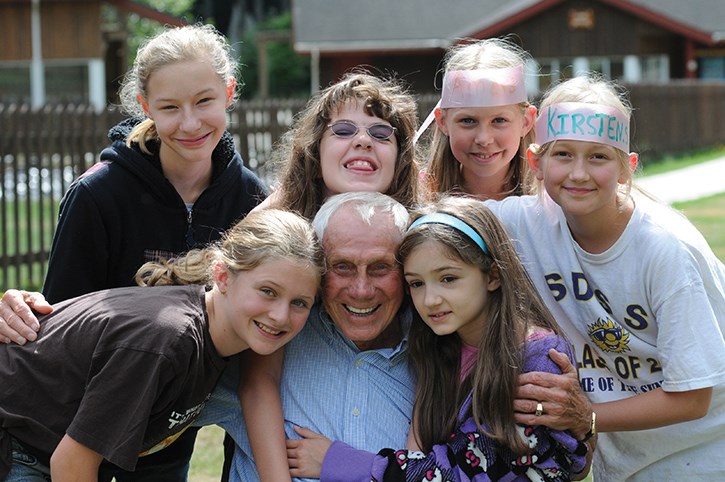It’s not hard to decide, between the 22 towers he developed and his five decades of philanthropy, which is Mel Zajac’s larger legacy.
And, sure, the man whose West End hotel hosted more than 200 Hollywood A-listers can distract with tales of Johnny Depp fisticuffs and Bob Hope’s cocktail of choice, but it’s his own story that proves most compelling.
Speaking in stops and starts over the phone, his fast-paced thoughts translated occasionally by daughter Carmen, the man who has spent his life helping society’s most vulnerable people first takes us back to the poverty-stricken northern end of 1930s Winnipeg.
“It was tough,” he says succinctly. Born the seventh of eight children, the death of his father prompted his early entry into the workforce, selling newspapers by age 11 and setting bowling alley pins by 13.
A trip to visit his sister in Vancouver in 1947 earned him the nickname, “the guy who came to dinner and never left”, and at age 19 Zajac settled on the West Coast.
He earned his next sobriquet, the “accidental” property developer, while working in a lumber supply house, where he met a salesman who taught him on weekends how to build houses. The houses – some of which are still standing – gave way to 10 low- and 22 high-rise developments in the Vancouver area, the most legendary being his modernist Pacific Palisades Hotel between Robson and Alberni, whose bar was the place to see and be seen between 1966 and 1985. (The hotel would be transformed by new owners into 234 rental units in 2012.)
Zajac has fond memories of working with his children, Corinne, Carmen, Karen, Mel Jr. and Marty, in the hotel while his celebrity friends ran amok. But, just as the hotel was entering the twilight of its heyday, gradually being eclipsed by newer, flashier models like the Sutton Place and Shangri-La, something no parent can prepare for happened: Mel and wife Irene lost their two sons to accidents just eight months apart.
Mel Jr. – an Olympic swimmer and Ironman – was killed in a kayaking mishap on the Chilliwack River in 1986. While the family was still recovering from that tragedy, Marty died in an avalanche while heli-skiing in the Cariboo. Grief, in some ways, would define the family from that point on.
Already ardent supporters of children’s charities through their golf tournament (now the longest-running such event in BC) the Zajac family started the Mel Jr. and Marty Zajac Foundation and began building a legacy in the boys’ names.
From 1987, the foundation would invest more than $20 million – much of that coming from Zajac’s circle of friends – into facilities and programs that brought about an extended care home for seniors, an international swim meet at UBC and medical ranch for kids, to name a few.
“It changed my course because I devoted my whole life to working and making things in memory of them,” says Zajac, who was appointed to the Order of Canada in 2007 for his philanthropy. “The schools I built, the seniors’ home, the park, everything is in memory of them. They’re helping me. Unbeknownst to anybody else, they’re behind me.”
Zajac Ranch, a Western-themed camp set on 40 acres along Stave Lake in Mission, provides children with serious and chronic illness the opportunity to have a complete, often life-changing, outdoor experience without interrupting treatment.
A converted correctional facility the family purchased with $2.2 million of their own money, it is now a complex comprised of 19 fully accessible buildings, the only of its kind in Canada, that offers the magic and normalcy of camp for the children, and respite for their families.
It costs $750,000 to run the 10-week camp. Much of that, says Carmen, comes from special events like White Spot’s always anticipated Pirate Pak Day for adults in August, and the upcoming Zajac Golf Classic, which rings in its 50th anniversary June 18 and promises to be a sun-addled putt down memory lane. The rest is through generous community contributions, be it money, materials or time.
“None of it would have been possible if it hadn’t been for my dad’s drive and his will to create this legacy in memory of his sons,” says Carmen, the foundation’s president for the past 19 years.
“It was going out and sharing my dad’s vision for the ranch and convincing other people that it was something the province could use, and would be a legacy that would carry on in perpetuity past my parents’ lifetime, past my lifetime and past my children’s lifetime. They turned something very tragic into something positive, not just for our family but for the community, the province... all of Canada, really.”
Now 86, Mel Sr. still goes into the office every day, and was just out at the ranch this weekend overseeing work in the garden. But you’re most likely to see him standing on a sidewalk downtown, staring up at the steel and concrete around him. A West End resident of 40 years, he says he can’t resist training a twinkling blue eye on the changes in his neighbourhood.
“It’s in my blood. I watch every building going up and, when I go for my walks, I record how their doing in my mind and make some notes. I watch the [Trump] building going up every day almost, and Telus Garden. It’s similar to art; you see a thing growing, you create something from the ground up. I call it a form of art.”
And that, surely, applies to both his life’s works.
Visit ZajacRanch.com to learn how you can send a kid to camp.
kelsey@wevancouver.com
twitter.com/kelseyklassen



